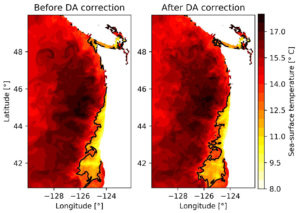In the ongoing race for improved weather systems, many research institutions continue to search for new and more powerful approaches for accurately predicting the weather. Now, a team from Oregon State University has used the supercomputing resources at the San Diego Supercomputer Center (SDSC) to develop an approach that could improve forecasts in the waters off the West Coast of the United States.
The research, which was published in Ocean Modelling in December, was conducted by Ivo Pasmans, a former doctoral student at Oregon State University, and Alexander Kurapov, an Oregon State professor. The duo set out to reduce forecasting errors in the three-day forecasts for water temperature, salinity levels, sea heights and currents off the coasts of Oregon and Washington. To do that, they used an approach called ensemble four-dimensional variational data assimilation – or En4DVAR – that allowed them to combine forecasts with observations.

“To generate an ensemble that realistically represents the model error statistics,” Pasmans said in an interview with SDSC, “we assumed that errors in the model’s wind forcing were the main source of model error, and we built on this concept using satellite wind observations and what’s known as a Bayesian Hierarchical Model to estimate a probability distribution for the wind errors.”
To run En4DVAR, the researchers needed high-performance computing – and for that, they turned to SDSC’s Comet supercomputer, an Intel Haswell system with 1,944 CPU nodes and 72 Nvidia-based GPU nodes (divided between K80s and P100s) that cumulatively deliver 2.76 peak petaflops.
“Running the ensemble of model runs needed by En4DVAR is very time consuming and we could not have used the En4DVAR approach without the 20 processors (480 processor cores) available to us on Comet,” Pasmans said. “Earth systems such as its oceans are stochastic systems that always contain random components, which make exact forecasts impossible. Thanks to supercomputers such as Comet, however, we were able to run high-powered data assimilation that allowed us to correct these errors to the best of our abilities and generate more accurate forecasts.”
The researchers are hopeful that their work will help make the waters of the upper West Coast safer and more productive.
“In general, more accurate predictions of the ocean also allow for more productive search-and-rescue missions,” Pasmans said. “Mostly, though, our Oregon/Washington shoreline is used by fishermen. In the summer there is a strong front in the ocean offshore Oregon, where nutrient rich deep-sea water surfaces and fosters plankton growth and attracts fish such that the correct forecasts of the location of the front can more precisely guide fishing boats.”
About the research
The research discussed in this article was published as “Ensemble of 4DVARs (En4DVar) data assimilation in a coastal ocean circulation model, Part I: Methodology and ensemble statistics” in the December 2019 issue of Ocean Modelling. It was written by Ivo Pasmans and Alexander L. Kurapov and can be accessed here.
To read SDSC’s article discussing this research, click here.



























































